The exhaust system consists of an exhaust manifold, a metal compensator, a catalytic converter, an additional and a main muffler
Replacing suspension pads for exhaust system parts
If the rubber suspension pads of the exhaust system are damaged, while the car is moving or when the engine is started, knocks can be heard under the bottom of the car due to the touch of the system parts on the body or rear suspension parts.
Pillows can be torn, lose elasticity, have cracks and tears.
When replacing pillows, we perform work on a viewing ditch or overpass.
Removing the neutralizer suspension pad
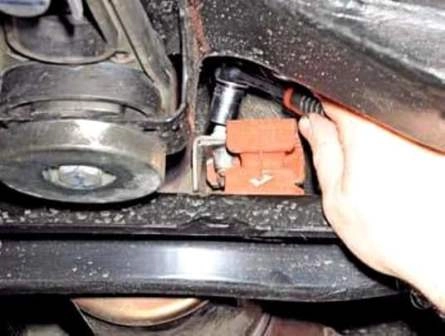
With a 13 head, unscrew the bolt securing the pillow to the bracket welded to the front end of the converter
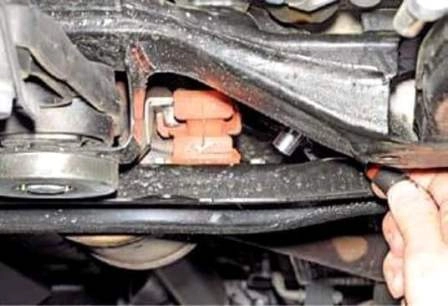
With a head of 10, unscrew the two bolts securing the pillow to the cross member of the body

Remove the pillow
Removing the additional muffler pipe suspension pad
To remove the pipe suspension cushion of the additional silencer, wring out the cushion from the pipe bracket with a screwdriver and inject a soapy solution into the resulting gap.

Using a large screwdriver, we pull the pillow off the pipe bracket.
In the same way, we inject a soapy solution into the gap between the body bracket and the pillow.
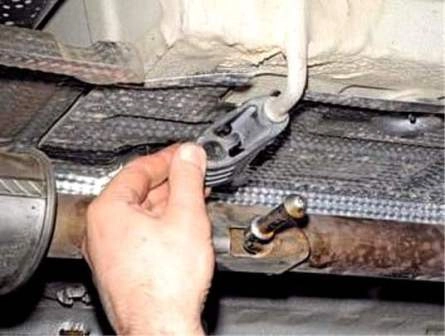
Pull the pillow off the body bracket
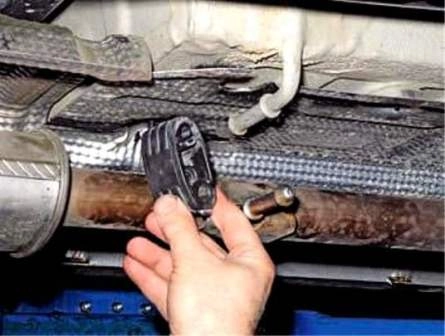
Remove the pillow
If we replace the pillow, then you can cut the old pillow with a knife.
Removing the main muffler pads
To remove the right cushion of the suspension of the main muffler, moisten the holes of the cushion with soapy water.
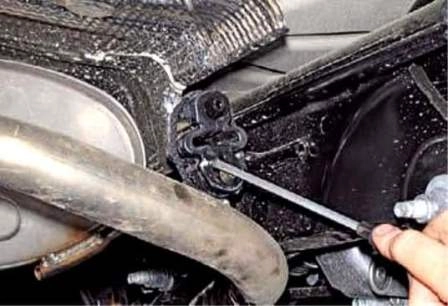
Use a large screwdriver to pull the pillow off the muffler bracket
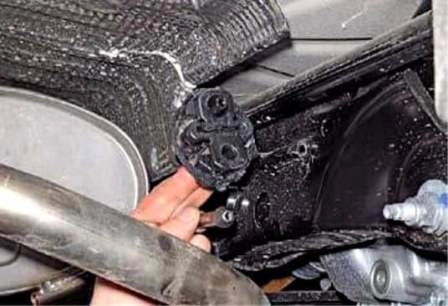
Pull the pillow off the body bracket
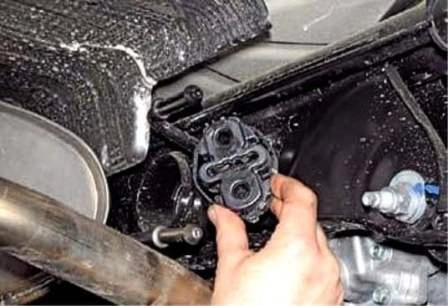
Remove the pillow
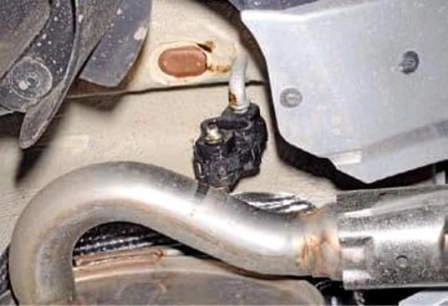
We also remove the left suspension cushion of the main silencer
Before installing new muffler suspension pads, we clean the body brackets and exhaust system elements.
Removing the exhaust system on a 4x4 car
We remove in turn three rubber suspension pads for the additional and main mufflers from the body brackets or brackets for the exhaust system, and also unscrew the bolt that secures the pad to the catalytic converter, see above.
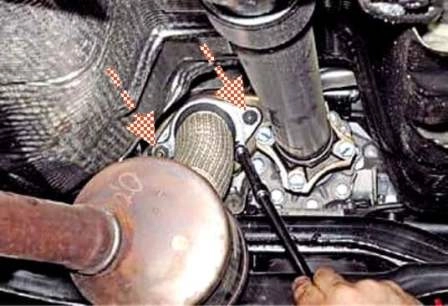
With a 10 head, unscrew the two nuts securing the metal compensator flange to the exhaust manifold flange
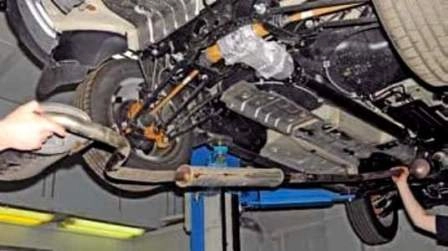
Removing the exhaust system
Remove the metal multilayer gasket from the exhaust manifold studs.
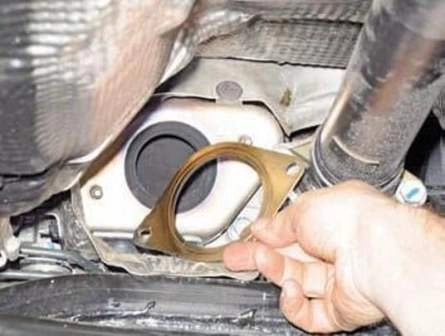
Install the exhaust system in reverse order.
Removing the exhaust system on a 4x2 car
To remove the parts of the exhaust system from the space between the body and the rear suspension beam, hang the rear of the car.
Remove in turn two rubber pads of the exhaust system suspension from the body brackets or brackets of the exhaust system parts.
We unscrew the nuts securing the metal compensator flange to the exhaust manifold flange (see above).

We move the exhaust system back and, passing the details of the exhaust system between the rear suspension beam and the bottom of the body, remove the exhaust system.
Install the parts in reverse order.
Replacing elements of the exhaust system
We replace the elements of the exhaust system in cases of burnout, through corrosion, major mechanical damage, or if the catalytic converter fails.
We carry out work on a viewing ditch or overpass. Operations for replacing elements of the exhaust system are shown on a 4x4 car.
If necessary, remove oxygen concentration sensors and CUD sensors of Renault Duster).
Since the design of the exhaust system is non-separable (with the exception of the connection of the exhaust manifold with the rest of the system), in order to replace its individual element, it is necessary to cut out the part to be replaced from the pipeline.
Auxiliary and main mufflers, as well as a catalytic converter with a metal compensator are separately supplied as spare parts.
To connect the parts, you must also purchase one or two (when replacing an additional muffler) special clamps.
Before replacing a metal compensator with a catalytic converter or an additional silencer, we mark the cut point on the pipe connecting the converter and the additional silencer.
To do this, we halve the distance (which is 80 mm) between the two marks located on the pipe.

Mark the place of cutting with chalk or marker
Cut off the pipe according to the marked mark.
After cutting the pipe, the expansion joint with catalytic converter can be replaced.
To do this, unscrew the bolt securing the system suspension cushion to the converter, disconnect the metal compensator flange from the exhaust manifold flange and remove the metal compensator with the catalytic converter.
Having installed a new metal expansion joint with a converter, we connect the pipes between the converter and the additional silencer with a special clamp.
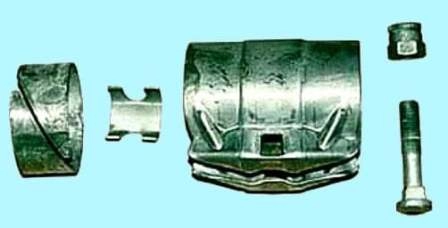
To replace an additional or main muffler, it is necessary to cut the pipe connecting them.
To do this, draw a line with chalk or a marker in the middle between the two marks on the pipe connecting the mufflers.
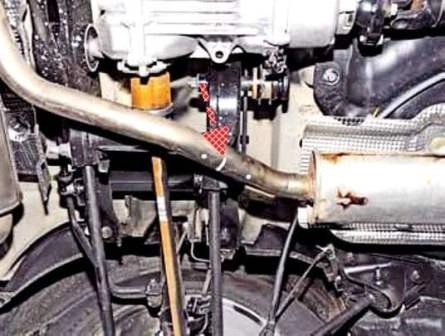
Use a hacksaw to cut the pipe along the marked mark.
Then, when replacing the main muffler, we take out the muffler brackets from the rubber cushions and remove silencer.
When replacing an additional silencer, we also cut the pipe connecting the silencer and the catalytic converter (see above), and remove the additional silencer by removing the bracket of its pipe from the rubber cushion.
When installing a new main or additional muffler, we use a special clamp at the junction of their pipes.
On a 4x2 vehicle, the exhaust system can also be replaced either as a whole or its individual elements, which are supplied as spare parts.
In order to replace the catalytic converter, it is necessary to cut the pipe connecting the catalytic converter and the additional muffler
The location of the cut is indicated on the pipe by marks in the form of two points, between which the cut should be made.
In order to replace an additional or main muffler, it is necessary once. cut the pipe connecting these parts according to the marks, as in the case of replacing the catalytic converter.
Removing the exhaust manifold
We carry out work when replacing the gasket in the connection between the exhaust manifold and the cylinder head or when repairing the cylinder head.
The junction of the manifold with the mating plane of the cylinder head is sealed with a metal gasket.
In the event that the gasket is burned out or the manifold fastening nuts are loosened, exhaust gases can escape through this connection to the outside, which is accompanied by a characteristic sound.
If tightening the exhaust manifold fastening nuts fails to eliminate the defect, it is necessary to replace the gasket.
We perform work on a viewing ditch or overpass.
Removing the air filter housing
Disconnect the flange of the metal compensator from the flange of the exhaust manifold of the exhaust system, see above.
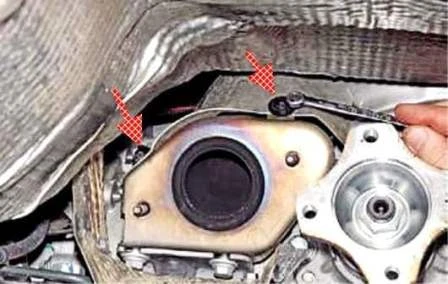
From the bottom of the car with an 8 spanner, unscrew the two bolts securing the upper protective screen to the exhaust manifold flange.
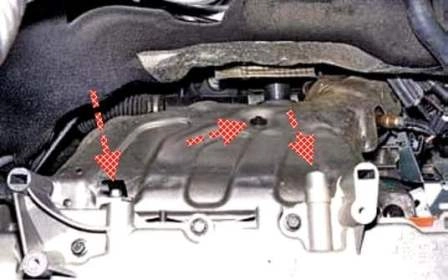
From above, with the same tool, unscrew the three bolts securing the upper heat shield to the exhaust manifold.
Remove the top heat shield.
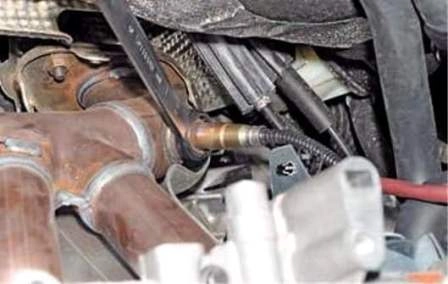
We unscrew the control oxygen concentration sensor from the exhaust manifold hole (article - Removing the ECU and CUD sensors of a Renault Duster car)
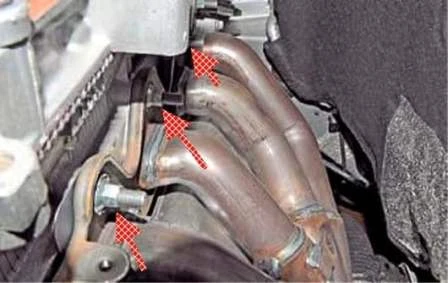
With a high head for 10, unscrew the nine nuts securing the exhaust manifold to the cylinder head
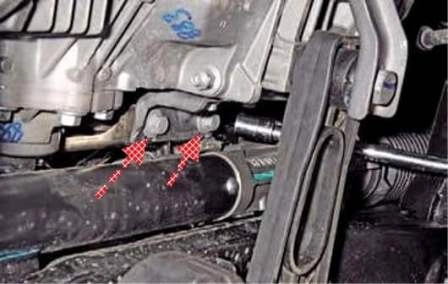
With a 13 head, unscrew the two bolts securing the exhaust manifold to the gearbox bracket by a few turns.
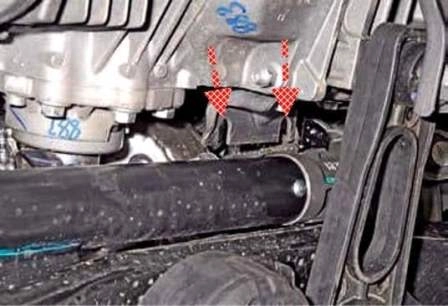
We shift the exhaust manifold along the studs of the cylinder head and remove the bolts from the grooves of the gearbox bracket
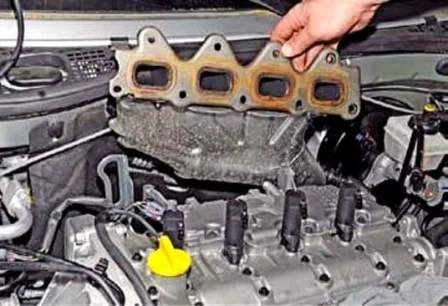
Remove the exhaust manifold

Remove the metal gasket of the exhaust manifold

With an 8 head, unscrew the four bolts securing the lower heat shield to the exhaust manifold
Capture the screen.
Before installing the exhaust manifold, we clean the mating surfaces of the cylinder head and exhaust manifold from carbon deposits and install a new gasket.
Before tightening the manifold mounting nuts, we apply graphite powder to the cylinder head studs.
We tighten the fastening nuts with a torque of 18 Nm.

We tighten in the sequence shown in the photo.
We tighten the bolts for fastening the exhaust manifold to the gearbox bracket after tightening the nuts for fastening the manifold to the cylinder head.





